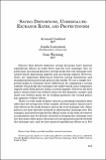Artículo
Saving distortions undervalued exchange rates and protectionism
Fecha
2015Resumen
Policies that distort domestic saving decisions have general equilibrium effects on trade flows and the real exchange rate. In particular increasing domestic savings keeps the real exchange rate undervalued depressing imports and increasing exports. However there are important differences between saving distortions and standard protectionist trade policies like tariffs. We use a simple twoperiod model to illustrate these differences by comparing a saving subsidy which keeps the exchange rate undervalued and a temporary import tariff. Both policies reduce current imports. However the first policy entails short-run welfare losses for the domestic country and short-run welfare gains for its trading partners the second policy has opposite welfare effects.
Colecciones
Descargar


